Now, if you've never had a dog for a pet, this is as far as you should read. That's because you won't understand the rest of this blog.
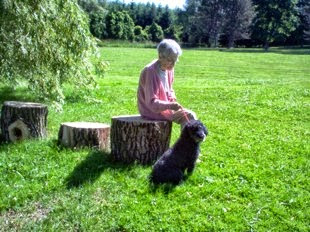
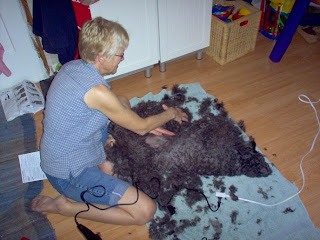
Tucker was 15 years old and you can see by the pictures, he was a miniature poodle - as tall as the breed gets and still be called "miniature". His heart belonged to a German Shepherd. From the time we got him, he was Rose Mary's dog. He'd share his affection with anybody who gave him a cookie or scratched his ears gently but he always got back to her. If I made a sudden motion toward her or smacked her leg, He was on me. He never bit anyone in 15 years but the barred teeth and that vicious snarl would confuse any stranger.
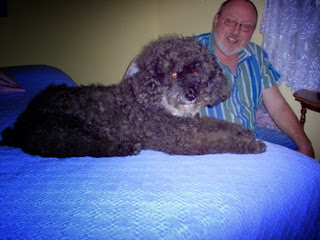 He loved babies. When he was younger, he would lay beside them just to make sure they would be alright. And don't you dare move too quickly to pick that baby up. You had to tell him what you were doing and get his permission to touch his ward.
He loved babies. When he was younger, he would lay beside them just to make sure they would be alright. And don't you dare move too quickly to pick that baby up. You had to tell him what you were doing and get his permission to touch his ward.Cushing's Disease (hyperadrenocorticism) affects the pituitary gland. (See end of blog for info.) Tucker manifested the first 5 symptoms which got progressively worse. He also was getting more and more crippled by arthritis, cataracts and he was deaf. The maddening part of all this is when he was producing excessive cortisone, he charged around like a puppy. At night it was most obvious as I watched him try to decide if it was worth the effort to climb the stairs to our bedroom. Most times he did.
He had a wicker basket in the living room by the sliding doors. Whenever someone came in you would hear him charging in from the kitchen, rooting through his basket for a toy, almost looking like he had a certain one in mind, then charge back out in order to present it to whoever had just come in. I've seen him on a number of occasions pull a toy out, make the move to deliver, then spit it out and get another one.
He loved fruits and vegetables. We would watch him in the garden as he checked out our tomato plants until he found a ripe one, then he would ever so gently, remove it, head for the lawn to lay down and savour it. Cantaloupe was another favourite. In fact there weren't too many fruits or vegetables he wouldn't eat.
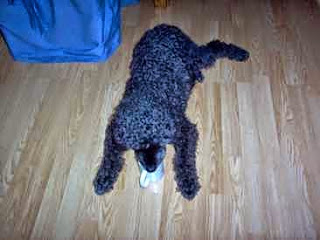 At night, there was a routine that had to be followed. First, Rose Mary had a coffee mug of milk to get her meds down. She always left some in the bottom for Tucker. He would slurp it down then lay on his tummy, knock the mug on its side and with closed eyes, get every evidence of the milk out of that mug. Immediately he went to the door because it was time to go out. We had to tie him up after dark because of the coyotes who enjoyed calling him out. After his evening constitutional, he made a bee line for the kitchen and if you didn't follow him, he would come back and remind you vocally with a little howl that you had missed the cue. This was dog cookie time, then off to bed.
At night, there was a routine that had to be followed. First, Rose Mary had a coffee mug of milk to get her meds down. She always left some in the bottom for Tucker. He would slurp it down then lay on his tummy, knock the mug on its side and with closed eyes, get every evidence of the milk out of that mug. Immediately he went to the door because it was time to go out. We had to tie him up after dark because of the coyotes who enjoyed calling him out. After his evening constitutional, he made a bee line for the kitchen and if you didn't follow him, he would come back and remind you vocally with a little howl that you had missed the cue. This was dog cookie time, then off to bed.My Mom graciously baby sat him for us when we went on holidays. He learned that if he did his night thing any time he came inside, Mom would give him a cookie. Well, why wouldn't she? He would stand in front of the cupboard and stare at the jar until she gave him one. It's funny, because when we came home, he wouldn't do it with us.
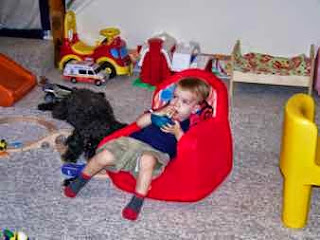
Rose Mary owns Three Bears Child Care and we have up to five children in the house every day. Over all the years, Tucker has never bit one of them. If they pull his ears, he gently but firmly takes their hand and moves it. Or he would vocalize so Rose Mary was aware that he was being put upon but never a bite. The kids loved him.
Last week an interesting thing happened. Brianna and Daniela have been at
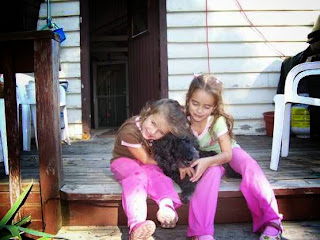 Three Bears for three years. Last week, Brianna (5 yrs old) was adamant that Rose Mary take her picture with Tucker. She just wouldn't let it go. Her sister then needed to get in the picture. Who knows why she asked except she did know from Tucker's original diagnosis that Tucker would die because of his illness. Well, Tucker died today.
Three Bears for three years. Last week, Brianna (5 yrs old) was adamant that Rose Mary take her picture with Tucker. She just wouldn't let it go. Her sister then needed to get in the picture. Who knows why she asked except she did know from Tucker's original diagnosis that Tucker would die because of his illness. Well, Tucker died today.Symptoms: Symptoms of Cushing's disease can be vague and varied and tend to appear gradually and progressively. It is thus easy to mistake Cushing's disease for normal aging. Additionally, many of the clinical symptoms are not unique to Cushing's and could reflect a number of other health concerns.
The most common symptoms include:
• increased/excessive water consumption (polydipsia)
• increased/excessive urination (polyuria)
• urinary accidents in previously housetrained dogs
• increased/excessive appetite (polyphagia)
• appearance of food stealing/guarding, begging, trash dumping, etc.
• sagging, bloated, pot-bellied appearance
• weight gain or its appearance, due to fat redistribution
• loss of muscle mass, giving the appearance of weight loss
• bony, skull-like appearance of head
• exercise intolerance, lethargy, general or hind-leg weakness
• new reluctance to jump on furniture or people
• excess panting, seeking cool surfaces to rest on
• symmetrically thinning hair or baldness (alopecia) on torso
• other coat changes like dullness, dryness
• slow regrowth of hair after clipping
• thin, wrinkled, fragile, and/or darkly pigmented skin
• easily damaged/bruised skin that heals slowly
• hard, calcified lumps in the skin (calcinosis cutis)
• susceptibility to infections (especially skin and urinary)
• diabetes, pancreatitis, seizures
It is generally either the increased water intake and urination or the coat changes which prompt an owner to have their dog evaluated by the veterinarian, as these dogs don't appear suddenly and dramatically ill. It is estimated that 80-85% of Cushingoid dogs have increased water consumption, drinking from 2-10 times normal amounts (normal is considered 1 ounce of water drunk per pound of body weight per day). 85-100% of Cushing old dogs have skin and coat changes. 80-90% of Cushingoid dogs have an increased appetite, and 90%-95% have a pot-bellied appearance. Considered a disease of middle and old age, dogs typically display symptoms at some point after 6 or 7 years of age. It is estimated that most dogs display some symptom(s) of the disease for one to six years before Cushing's is actually suspected and diagnosed. Certainly it is harder to ignore a dog that urinates throughout the house or a dog who is balding than it is to overlook an older dog who is gradually slowing down on walks.
Other indirect symptoms to consider are the disappearance of previous inflammatory conditions. Dogs with chronic allergies or arthritis may appear considerably better when they develop Cushing's, due to the heavy doses of cortisone they are giving themselves.